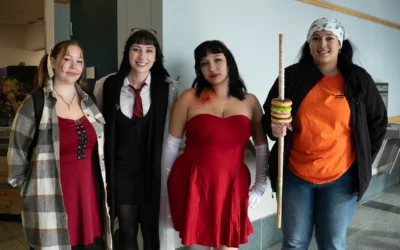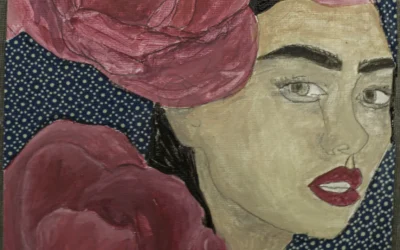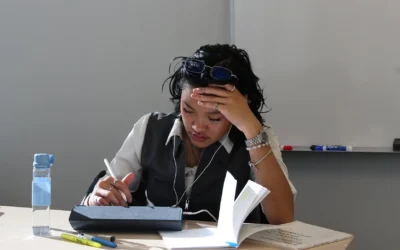“It should not take George Floyd’s death, the #VogueChallenge, as well as Anna Wintour’s reckoning with race for us to acknowledge the fact that BIPOC (Black, Indigenous, people of colour) are still not being represented in the fashion industry,” says Camille Anwuli. Anwuli is a part-time content creator from Edmonton who is currently working on her podcast called The Glow Up Table, meant to empower women “who are transforming their lives and taking first steps to walking in their purpose,” she says.
The senseless killing of George Floyd a few months ago sparked one of the biggest uproars against racism in history. As reported by Al Jazeera, “protests erupted in at least 140 US cities, with thousands of people taking to the streets against police violence,” in support of Black Lives Matter (BLM), demanding change and justice be brought to unnecessary deaths of Black individuals at the hands of police, and for all the racism that has been circulating the world towards BIPOC. The protests raised various issues of racism and discrimination in different industries around the world that have been ignored for many years. Protestors, advocates, and influencers are demanding their voices be heard and justice be served.
Just as racism is present on the streets, it has also been vastly present in the fashion industry. During the protests, some designers and celebrities from the fashion industry voiced and pledged their support for the cause, but some among them are not putting that support into practice. For example, editor-in-chief of Vogue Anna Wintour posted her support for the BLM movement, but comments on the post from her followers claimed that Wintour failed to provide opportunities for women of colour at the publication. After receiving backlash from fans and former employees, Page Six reported that Anna Wintour has admitted to her “hurtful and intolerant” behaviour.
The glitz and glam of the fashion industry are like a coin: two-faced. One side showing support for Black people and the other creating code names to identify them in retail stores, as posted by @diet_prada (an Instagram account known for calling out copycats and bad or discriminatory practices) on June 10, 2020. Lela London, a senior contributor in Forbes, writes in her article It’s Time For The Fashion Industry To Stand Up To Racism, “fashion has made billions from Black culture for decades, from zoot suits to stolen streetwear. Both overtly and deceptively treading the line between appreciation and appropriation.”
The trend of wearing “streetwear” (such as sneakers or tracksuit pants) as everyday clothing originated in the Black community as reported by Danny Parisi on Glossy, a trend that was initially snubbed for their cheap outlook. However, the increase in popularity of Black-owned brands, such as Phat Farm, FUBU, and Karl Kani, opened the doors to this fresh new style genre created by the Black community in the ‘90s. According to an article written by Henry Lifshits on INDIE, “the resurgence of urbanwear has seen labels like Tommy Hilfiger and Calvin Klein dominating the mainstream.” The problem arises when some brands profit off these trends but on the flip side are producing problematic and sometimes racist products. For example, Dolce & Gabbana created earrings and dress prints that romanticized images of Black women living a happy slave life. The earrings appeared on the runway during their Spring 2013 collection that had no Black models as reported by Julee Wilson on HuffPost.
The question is, when will this change? The global fashion market has been expanding every single day and has not slowed down since the digital revolution. But, often, the fashion industry does not reflect the reality it showcases, where BIPOC are also at the forefront of their brands. There are many individuals in Edmonton that are voicing their concerns regarding the lack of representation and racism that goes on here — like Anwuli.
“I like to advocate for what is right by sharing not only what I know but also taking the time to research topics and issues that I am unfamiliar with before I provide my two cents on it,” she says.
Despite Canada being one of the most racially diverse countries in the world, that diversity is not reflected in the fashion industry, according to Anwuli. “It is disheartening,” she says. The advancing of the digital age has allowed us access, both through online news and social media platforms, to information on what racism and cultural appropriation is in the fashion industry. By now, people should be aware of the lack of diversity in the industry, as Beverly Johnson, the first Black woman to appear on the cover of American Vogue, mentioned in Good Morning America, when she talked about the financial and economic side of the fashion industry still lacking Black people. Instead, “we still have to call in and call out brands in the fashion industry for their lack of representation,” Anwuli says.
Growing up, Alimatu Massaquoi, a psychology student at the University of Alberta, has always noticed the lack of diversity in the fashion industry being apparent. “Watching older seasons of Project Runway, young and wondering why none of the designers or judges looked like me,” she says. The show “planted a seed of doubt” in her, making her believe that a Black woman could not be a well-known designer or be successful in the industry.
For Anwuli, while the local scene in Edmonton is diverse, she hopes to see more local brands provide opportunities for BIPOC. There is still much work the local scene has to do to ensure a more diverse industry. “Canada is called a cultural mosaic for a reason, and it needs to be showcased in the fashion scene. There are so many talented BIPOC photographers, content creators, entrepreneurs who have to work twice as hard to get their foot in the door and prove that they are not a statistic.”
Anwuli felt pressured to conform to the trendy bloggers that had been popular when she was working to launch her own online presence. It was not easy having only passion, as sometimes it does not help in becoming famous and popular. “I felt out of place style-wise, for my fashion sense was fixated on hip-hop culture and athleisure and I felt pressured to conform to the style of other bloggers,” she says. Anwuli was someone who did not want to fit in, but wanted to stand out with her personal style. However, despite the pressure, the only way she could thrive in the industry was to be unapologetic. “I know that notion is the same for a lot of Black creators. We should not have to beg, bow, and conform to anything, ever.”
For Massaquoi, her style and her hair have always been her identity. “ My natural hair was a big topic of discussion throughout school growing up; I would be terrified to take out my braids because I knew the kids at school would ask ‘where’d your hair go? ’ and I dreaded having to explain the concept of braids to them for the third time that school year.” She also talks about how some of the same people who’ve made fun of her in braids can be seen in braids now that they are trendy. “I believe as humans we all are meant to share our cultures and share knowledge with one another. However, the lack of awareness of the origins of the hairstyle misleads others and takes way the cultural ties to the specific hairstyle.”
The appropriation of BIPOC happens behind-the-scenes, despite an article in The Fashion Spot by Cordelia Tai stating, “Spring 2019 was the most racially diverse fashion month ever. After examining 229 shows and 7,431 runway castings, we found that 36.1 per cent of all castings across New York, London, Milan and Paris went to models of color. (Essentially two in every five models were people of color.) That’s a significant — 3.6 point increase from Fall 2018’s 32.5 per cent.” Los Angeles based Black influencer Jackie Aina discussed the Pull Up for Change campaign on her Instagram on June 3, 2020. The campaign asked brands and corporations who stood in solidarity for BLM a few months ago to release the number of Black employees they have at a corporate and executive level within their organization. The results were posted on the @pullupforchange Instagram page, where statistics show Levi’s, Gap, and Nike with very little to no percentage of Black people on their senior leadership teams. These results were shocking considering the fact that these companies use BIPOC as models or collaborators to make their brands look as if they know and are supporting the culture. For example, Nike, a brand that uses people from diverse cultures like Micheal Jordan and Colin Kaepernick who have appeared in Nike advertising campaigns and collaborations as seen properly laid out by Ivan De Luce in an article on Business Insider. In reality, the companies lack these exact same people in their boardrooms where decisions are made, as presented transparently on their websites. “It really comes down to the CEO’s, executives, and directors’ knowledge and awareness of diversity.” says Anwuli.
On fitting the industry standards here in Edmonton, Anwuli says she has not been judged for her skin colour. However, her style has played some part in not fitting in with the industry standards. “My style focuses a lot on ‘90s hip-hop culture, for it was what I grew up on. And so for that, I don’t land many collaborations with fashion brands. But yet, their pieces are streetwear-inspired and they choose blackfish models (people who pretend to be Black by spray tan or using darker makeup) as opposed to models who are Black.”
In a conversation with one of her friends who is a model in Edmonton, Massaquoi’s friend had mentioned “some runway organizers only choose a fixed number of Black models while having a plethora of white or white-passing models in their shows.” Sometimes they attempt to be more inclusive either by choosing someone who is socially accepted (light skin tone and loose curls) or someone from the opposite spectrum (having a darker skin tone and short curly hair).
“This to me, places beauty in a box. In order for the fashion industry to expand and diversify we need everybody on the spectrum not only the extremes,” says Massaquoi.
The protests that happened have been showing some improvements, from the aspects of the justice system. Hence, Anwuli believes that “if a protest can make a difference in those areas, I am sure the fashion industry can follow suit.” She says that the change should start with the people in power by creating space for BIPOC as models and creators. “Don’t surround the women of colour, surround the white woman. We are not your sidekicks, we are the blueprint.”
Images provided.





0 Comments